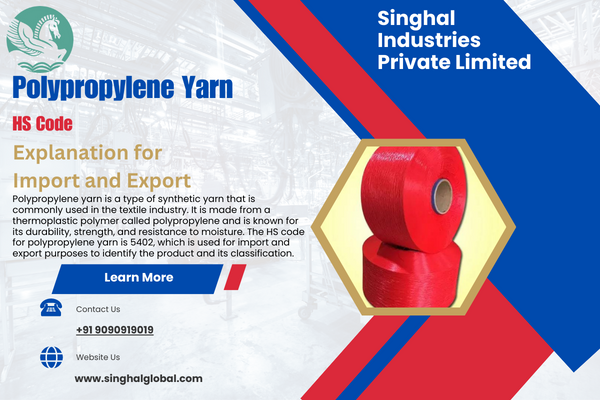Polypropylene Yarn Harmonised System (HS) Code Explanation for Import and Export
The HS Code for polypropylene yarn is necessary if you want to import or export it. This number is used to categorize items for customs reasons; it may affect the amount of taxes and fees you must pay. Here, you'll find a comprehensive breakdown of the HS code that applies to polypropylene yarn.
Why do we need HS codes?
The Harmonised System (HS) is a method of product classification that has gained worldwide acceptance. Over 200 nations make use of this system, which the World Customs Organisation (WCO) created. For customs reasons, commodities are assigned a six-digit designation known as the HS code. It aids in harmonizing the categorization of commodities between nations and can affect the fees associated with bringing in or sending out merchandise.
Polypropylene yarn—what is its HS code?
Yarn made of polypropylene has an HS code of 5402.20. Synthetic fibers and filaments are classified under HS Chapter 54. When importing or exporting polypropylene yarn, it is crucial to use the appropriate HS code to guarantee that the appropriate customs charges and taxes are applied. It's also worth noting that the HS code for polypropylene yarn might change based on the exact variety being traded.
When trading internationally, what role does the HS code play?
The HS code is used by customs officials to categorize merchandise and establish duty and tax rates. The right HS code must be used when importing or exporting polypropylene yarn to guarantee that the items are properly categorized and that the appropriate tariffs and taxes are paid. Customs agents also make use of the HS code in order to classify and trace incoming cargo. In order to prevent unnecessary complications during customs clearance, it is crucial that the HS code utilized is correct and up-to-date.
Why is it important to use the right HS code?
When importing or exporting polypropylene yarn, using the right HS code is crucial. First, it guarantees that the proper tariffs and taxes are levied on the merchandise. This may reduce the likelihood of additional fees or delays associated with customs clearance. Second, if the proper HS code is used, the items will be less likely to be delayed by customs officials. The clearance procedure can be sped up and the shipment delivered on time if this is done. Finally, it's crucial for supply chain management and inventory control to use the right HS code to trace items.
This guide will help you find the right HS code for your polypropylene yarn.
It might be difficult to get the right HS code for your polypropylene yarn items, but doing so is crucial for trade. Yarn made of polypropylene has an HS code of 5402.20.00. For tariff reasons, items containing polypropylene yarn are classified here. It's worth noting, though, that this broad category has a number of subcategories that might be more relevant to your offer. Considerations like yarn type, yarn denier, and yarn color are helpful in zeroing in on the right subcategory. The relevant HS code for polypropylene yarn goods should be determined with the help of a customs broker or trade expert.


.png)
Comments
Post a Comment